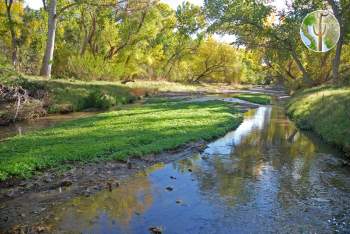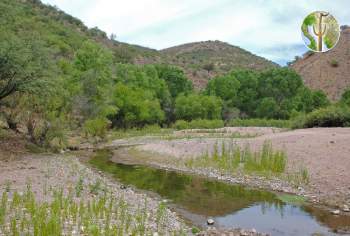Santa Cruz River
State of the Santa Cruz River
The Santa Cruz River has a compelling human history. Telling this story can awaken a deeper emotional curiosity about the river and entice more people to explore the region’s rich heritage. The Sonoran Institute is not the first to recognize and share the river’s fascinating story. The State of the Santa Cruz River builds on the work of the Santa Cruz Valley Heritage Alliance. The nonprofit Heritage Alliance provides ongoing leadership in recognizing the important link between nature and culture.
State of the Santa Cruz River - Conservation Inventory
The Santa Cruz River and other riparian areas in the watershed have long been the backbone of the region’s natural and cultural heritage. This rich history is highlighted in the State of the Santa Cruz River.
This companion document, State of the Santa Cruz River—Conservation Inventory, aims to acknowledge the numerous conservation efforts underway throughout the region that promote watershed health as well as protect and restore the river.
Report, Findings And Determination Regarding The Navigability Of Small And Minor Watercourses In Santa Cruz County, Arizona
Spanish travelers or settlers in Santa Cruz County until 1691 when a Jesuit missionary, Father Eusebio Francisco Kino carne to the valley to establish missions and convert indigenous populations to Christianity. The impact Father Kino had on Santa Cruz County, either directly or indirectly, cannot be underestimated.
Floating the Santa Cruz River in inflatable kayaks
The upper Santa Cruz River in Arizona is navigable by boat! The boats (IKs) are smaller than full rafts and float in a few inches of water. We had to drag occasionally and be careful of debris, but were able to float several miles of the Rio Santa Cruz!
This stretch has flows, which are supported by effluent from a sewage treatment plant in Nogales, AZ.
A Living River: Charting the Health of the Upper Santa Cruz River, 2010
For thousands of years, rivers in the arid Southwest have sustained people and supported an abundance of plants and wildlife. Though at times unnoticed, the numerous services that these rivers perform provide substantial benefits to the people living near them. For example, the plants growing along the river naturally slow flood flows, improve air quality, and provide shade. Soils in the floodplain, meanwhile, filter and clean the river water as it recharges the groundwater aquifer that supports local residents.
A Living River: Charting the Health of the Upper Santa Cruz River, 2008
For thousands of years, people in the arid West have built their communities near rivers that supply drinking water, serve as navigation corridors, and support hundreds of plant, fish, and wildlife species. The Upper Santa Cruz is such a river, having sustained human communities for more than 3,500 years. From its headwaters in the San Rafael Valley in Arizona, the Upper Santa Cruz River flows south into Mexico where it completes a 25-mile U-turn and flows north back into the United States through Santa Cruz County, Arizona.
Celebrating Arizona’s Rivers - the Santa Cruz
Created as part of a collection of Arizona river overview documents titled "River of the Month Series, Celebrating Arizona’s Rivers".


